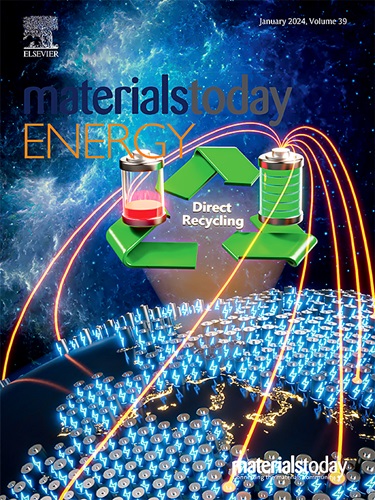Bathocuproine, an Old Dog New Tricks for Boosting the Performance of Perovskite Solar Cells
IF 8.6
2区 材料科学
Q1 CHEMISTRY, PHYSICAL
引用次数: 0
Abstract
Perovskite solar cells (PSCs) have demonstrated extensive prospects for future applications. However, defects remain as the crucial factor that impedes their further advancement in performance, and passivation of the interfaces (such as the buried and/or top interfaces) is regarded as one of the most effective approaches. Herein, we aim to address another important interface, namely, the indium tin oxide/electron transport layer (ITO/ETL) interface in n-i-p structured devices. Since electron transport layers are typically fabricated using commercial nano tin dioxide, which often display insufficient density. To combat this, we employ the most commonly used bathocuproine (BCP) material to treat the ITO/ETL interface. The incorporation of BCP diminishes the direct contact between the perovskite and ITO layers, while also passivating buried interface and adjusting the crystal orientation of perovskites. Furthermore, the substrate layer exhibits improved transparency, consequently elevating the utilization rate of light by perovskite. As a result, the BCP-based PSC exhibits an impressive efficiency greater than 22%, surpassing the control one of 19.91%, and which simultaneously demonstrates excellent stability. Notably, the optimization of this interface has universal applicability in the improvement of PSCs performance.老狗出新招:Bathocuproine 提高过氧化物太阳能电池的性能
过氧化物太阳能电池(PSCs)的未来应用前景十分广阔。然而,缺陷仍然是阻碍其性能进一步提高的关键因素,而界面(如埋入界面和/或顶部界面)的钝化被认为是最有效的方法之一。在此,我们旨在解决另一个重要的界面问题,即 ni-i-p 结构器件中的铟锡氧化物/电子传输层(ITO/ETL)界面。由于电子传输层通常使用商用纳米二氧化锡制造,其密度往往不足。为了解决这一问题,我们采用了最常用的bathocuproine(BCP)材料来处理ITO/ETL界面。BCP 的加入减少了包晶和 ITO 层之间的直接接触,同时还钝化了埋藏界面并调整了包晶的晶体取向。此外,衬底层的透明度也得到了改善,从而提高了包光体对光的利用率。因此,基于 BCP 的 PSC 效率超过了 22%,超过了 19.91% 的对照效率,同时还表现出卓越的稳定性。值得注意的是,该界面的优化在提高 PSC 性能方面具有普遍适用性。
本文章由计算机程序翻译,如有差异,请以英文原文为准。
求助全文
约1分钟内获得全文
求助全文
来源期刊

Materials Today Energy
Materials Science-Materials Science (miscellaneous)
CiteScore
15.10
自引率
7.50%
发文量
291
审稿时长
15 days
期刊介绍:
Materials Today Energy is a multi-disciplinary, rapid-publication journal focused on all aspects of materials for energy.
Materials Today Energy provides a forum for the discussion of high quality research that is helping define the inclusive, growing field of energy materials.
Part of the Materials Today family, Materials Today Energy offers authors rigorous peer review, rapid decisions, and high visibility. The editors welcome comprehensive articles, short communications and reviews on both theoretical and experimental work in relation to energy harvesting, conversion, storage and distribution, on topics including but not limited to:
-Solar energy conversion
-Hydrogen generation
-Photocatalysis
-Thermoelectric materials and devices
-Materials for nuclear energy applications
-Materials for Energy Storage
-Environment protection
-Sustainable and green materials
文献相关原料
公司名称
产品信息
阿拉丁
4-tert-butylpyridine
阿拉丁
dimethyl sulfoxide
阿拉丁
cesium iodide
阿拉丁
bis(trifluoromethane)sulfonimide lithium salt
 求助内容:
求助内容: 应助结果提醒方式:
应助结果提醒方式:


